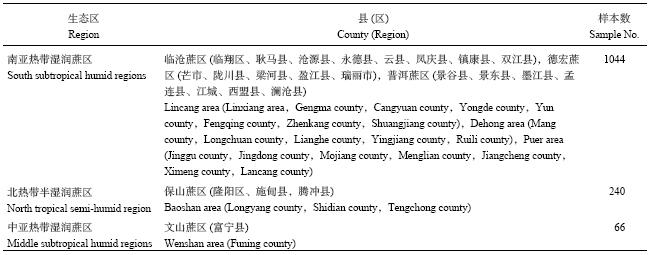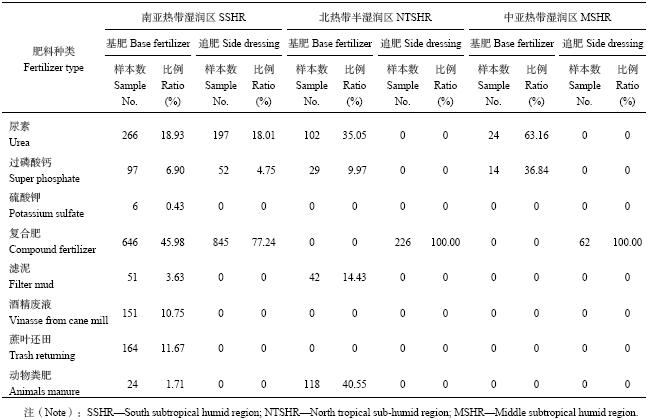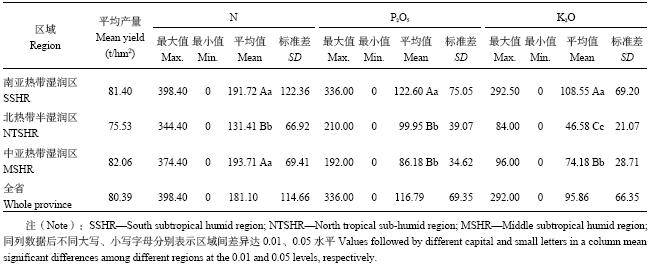2. 云南省甘蔗遗传改良重点实验室,云南开远 661699
2. Key Laboratory of Sugarcane Genetic Improvement of Yunnan Province, Kaiyuan, Yunnan 661699, China
云南省是我国第二大甘蔗和食糖生产基地,云南蔗区主要分布于德宏、临沧、保山、普洱、红河、西双版纳、玉溪、文山等8个州 (市)[1–3]。2012、2013年云南省甘蔗种植面积超过360.1 khm2,甘蔗农业产量22.05 Mt,工业产量17.58 Mt,食糖产量2.24 Mt[4–5]。甘蔗种植已成为振兴云南省边疆民族农业经济和农民增收的重要支柱产业。农田施肥是保持土壤肥力和增加作物产量的重要环节之一[6–8],尽管提高甘蔗产量和糖分主要是依靠品种的选育和栽培条件的改善来实现,但是植物营养和合理施肥同样是影响作物产量和品质的重要因素[9–10]。合理施肥可以增加产量,提高糖分。因此,调查与研究全省甘蔗施肥状况对甘蔗生产具有重要的意义。然而,关于云南省甘蔗的施肥现状研究却少有报道,本文通过蔗农施肥现状的抽样调查和统计数据资料的分析,拟从甘蔗产量、施肥量、施肥方式、施用肥料品种等方面对甘蔗施肥现状进行评价,为云南省甘蔗生产中养分优化管理提供依据。
1 材料与方法 1.1 数据收集与调查方法数据主要来源于课题组对全省不同生态蔗区蔗农抽样调查[11–12]。本研究在2013年至2014年榨季调查情况的基础上进行分析总结,针对蔗区农户,在云南省3个生态蔗区的6个甘蔗主产区 (临沧、保山、德宏、文山、普洱) 采用统一问卷实地走访调查的方式,共调查了1350户蔗农。调查内容主要包括:甘蔗产量,肥料种类、施肥方式及施用量等。具体调查地点分布及样本数见表1。
| 表1 调查地点分布及样本数 Table 1 Distribution of the sites and number of samples investigated in the study |
 |
化肥养分的单质肥料按各肥料养分含量标准计算,复合肥与专用肥按实际调查记录值计算,没有记录的按调查多数平均值计算。
1.3 数据处理方法调查数据采用Epidata (V3.02) 软件进行问卷数据录入,对于有些逻辑上不匹配的调查问卷,笔者采用电话回访的形式,再次对该蔗农的有关信息进行询问核实。应用Excel 2010进行数据统计分析。
2 结果与分析 2.1 不同生态蔗区甘蔗产量现状根据调查结果将甘蔗产量分为5级[13](表2),对不同生态蔗区1350 户蔗农甘蔗生产状况进行调查表明,南亚热带湿润区甘蔗平均产量最高,为81.40 t/hm2,其次为中亚热带湿润区平均产量为81.73 t/hm2,北热带半湿润区的甘蔗平均产量最低为75.44 t/hm2,全省甘蔗平均产量80.35 t/hm2。南亚热带湿润区甘蔗产量中等的蔗农占样本总数的28.4%;产量很低和偏低蔗农占样本总数一半以上,为53.4%;产量很高和偏高蔗农仅占18.2%。北热带半湿润区甘蔗产量中等的蔗农占13.8%;很低和偏低蔗农占79.2%;产量偏高蔗农仅占7.1%,未调查到产量很高的蔗农样本。中亚热带湿润区甘蔗产量中等的蔗农占27.3%;产量偏低和很低蔗农占68.2%,未调查到产量很高蔗农样本。结果表明,全省蔗区产量在中等偏低水平。
| 表2 云南省甘蔗产量分布 Table 2 Yield levels of sugarcane in Yunnan Province |
 |
由不同生态蔗区蔗农施用的肥料种类 (表3) 可知,化肥种类主要包括单质氮磷钾肥及复合肥;有机肥种类虽多,但蔗区以滤泥、酒精废液、蔗叶还田及动物粪肥为主。南亚热带湿润蔗区基肥以复合肥比例最大,占基肥施肥品种的45.98%;其次是尿素,占18.93%;再次是有机肥的蔗叶还田,占11.67%。追肥也是以复合肥为主,占追肥施用品种的77.24%;其次是尿素,占18.01%;再次是过磷酸钙,占4.75%。该蔗区施用基肥的蔗农比例为99.71%,施用追肥的蔗农比例为47.32%。
北热带半湿润蔗区基肥以有机肥中的动物粪肥比例最大,占基肥施肥品种的40.55%;其次是尿素,占35.05%;再次是有机肥的滤泥,占14.43%。追肥全部施用复合肥。该蔗区施用基肥的蔗农比例为47.08%,施用追肥的蔗农比例为94.17%。
中亚热带湿润蔗区基肥以尿素和过磷酸钙为主,其分别占基肥施肥品种的63.16%和36.84%。追肥全部施用复合肥。该蔗区施用基肥的蔗农比例为45.45%,施用追肥的蔗农比例为93.94%。
调查结果得出,蔗区施用复合肥的比例较高,其施用的样本比例占到了总样本数的94.13%,而单质肥料施用较少,施用尿素的样本比例占到了总样本数的41.63%,而施用过磷酸钙的样本比例仅占到了总样本数的15.09%,施用硫酸钾的样本比例则更少,仅为0.45%。由此可以得出,复合肥因具有施用简单、方便、营养成分较为全面的优点,大部分蔗农都选择施用。
2.3 不同生态蔗区甘蔗化肥养分投入状况不同生态蔗区甘蔗化肥养分投入状况调查表明 (表4),全省化肥氮 (N)、磷 (P2O5) 和钾 (K2O) 投入量分别是193.67 kg/hm2、116.79 kg/hm2和95.86 kg/hm2。南亚热带湿润蔗区的化学氮肥、磷肥和钾肥投入量最高,氮肥 (N) 投入量变化在0~525.60 kg/hm2,平均为207.98 kg/hm2,磷肥 (P2O5) 投入量变化在0~336.00 kg/hm2,平均投入量分别为112.60 kg/hm2,钾肥 (K2O) 投入量变化均在0~292.50 kg/hm2,平均投入量分别为108.55 kg/hm2。北热带半湿润蔗区的化学氮肥投入量变化在0~344.40 kg/hm2,平均投入量最低,为131.41 kg/hm2,磷肥 (P2O5) 投入量变化在0~210.00 kg/hm2,平均为99.95 kg/hm2,钾肥 (K2O) 投入量变化在0~84.00 kg/hm2,平均投入量最低,为46.58 kg/hm2。中亚热带湿润蔗区的化学氮肥用量变化在0~374.40 kg/hm2,平均为193.71 kg/hm2,磷肥 (P2O5) 用量变化在0~192.00 kg/hm2,平均用量最低,为86.18 kg/hm2,钾肥 (K2O) 用量变化在0~96.00 kg/hm2,平均用量为74.18 kg/hm2。蔗区甘蔗养分主要由化肥提供,由表4可得出,云南省各生态蔗区甘蔗化肥养分投入量均表现为氮肥 > 磷肥 > 钾肥。
| 表3 不同生态蔗区主要化肥品种提供的养分比例 (%) Table 3 Proportion from the individual fertilizer used in sugarcane production in different regions |
 |
| 表4 不同生态蔗区甘蔗化肥投入量 (kg/hm2) Table 4 Nutrient inputs in sugarcane fields in different regions |
 |
不同生态蔗区不同肥料投入水平下蔗农户数和产量分布 (图1~图3),结果表明,随着化肥氮、磷、钾养分投入量的增加,3个不同生态蔗区甘蔗产量均呈现稳定上升的趋势。氮肥施用量超过300 kg/hm2时,平均产量分别达95.06 t/hm2、90.05 t/hm2和84.75 t/hm2。磷肥施用量为150 ~ 200 kg/hm2时,平均产量分别达96.56 t/hm2、77.69 t/hm2和83.25 t/hm2。钾肥施用量超过 75 kg/hm2时,平均产量分别达87.12 t/hm2、83.83 t/hm2和83.62 t/hm2。说明在云南蔗区合理增施氮、磷、钾肥可增加甘蔗的产量,这与前人的研究结果一致[14–17]。
 |
| 图1 南亚热带湿润区不同肥料投入水平下蔗农户数和产量 Fig. 1 Distribution of households and yields of sugarcane under different fertilizer input levels in the south subtropical humid region |
 |
| 图2 北热带半湿润区不同肥料投入水平下蔗农户数和产量 Fig. 2 Distribution of households and yields of sugarcane under different fertilizer input levels in the north tropical sub-humid region |
 |
| 图3 中亚热带湿润区不同肥料投入水平下蔗农户数和产量 Fig. 3 Distribution of households and yields of sugarcane under different fertilizer input levels in the middle subtropical humid regions |
不同生态蔗区甘蔗施肥以两次施肥 (基肥 + 追肥) 和一次施肥 (追肥) 为主。基肥施肥时间是在甘蔗下种时随蔗种一起施入,在甘蔗进入拔节伸长期时进行追肥。调查结果表明,不同生态蔗区追肥均在4—6月份完成。
施肥的深度直接影响根系对养分的吸收效率[18–21]。对不同生态蔗区施肥方式和深度的调查表明,新植甘蔗基肥 (包括化肥和有机肥) 施用均采用条施的方式,中耕培土期的追肥施用主要采用穴施或者条施的方式,分别占到总调查蔗园数的77%和20%,采用撒施方式的蔗农所占的比例相对较小。就施肥深度而言,全省各生态蔗区基肥施用条施的深度存在较大差异,从15 cm左右至35 cm深不等。然而各生态蔗区在追肥的施用过程中存在施肥后不盖土的现象,且各生态蔗区之间有较大差异。调查发现,南亚热带湿润蔗区追肥后不进行覆土的蔗农占样本总数的33.52%;北热带半湿润蔗区追肥后不进行覆土的蔗农占样本总数的48.39%;中亚热带湿润蔗区追肥后不进行覆土的蔗农占样本总数的82.53%。
2.6 不同生态蔗区甘蔗施肥状况评价 2.6.1 合理施肥量的确定由于蔗区有机肥施用比例较小,施用的有机肥大部分只有经过微生物分解后才能被吸收利用,且有机肥中速效养分和迟效养分的比例不确定。因此,本研究在确定合理施肥量时只考虑化肥投入。通过调查分析云南不同生态蔗区甘蔗养分投入量与产量的关系,结合测土施肥推荐指标[22–23]和相关资料[24–25]得出云南省蔗区肥料的合理用量。甘蔗产量介于85.00~90.00 t/hm2时,建议施肥用量为:N 285~350 kg/hm2,P2O5 200~250 kg/hm2,K2O 175~225 kg/hm2。
2.6.2 施肥量分级标准确定在蔗区合理施肥量的基础上,将N、P2O5、K2O施用量分为很低、偏低、合理、偏高和较高5级,如表5所示。将小于合理用量50%定义为“很低”,大于合理用量50%为“较高”,“合理”与“很低”之间为“偏低”,“合理”与“较高”之间为“偏高”。
| 表5 不同生态蔗区施肥量分级标准 Table 5 Classification standards of fertilization rates in different regions |
 |
据表5 确定的不同生态蔗区施肥量分级标准,对云南省不同生态蔗区甘蔗化肥施用量进行分析与评价 (图4)。由图4可知,南亚热带湿润区化学氮肥、磷肥和钾肥投入合理比例低,分别为18.2%、5.3%和7.4%,很低和偏低比例均较高,均未调查到投入较高样本。北热带半湿润区氮肥和磷肥投入合理比例分别为3.3%和2.5%,很低和偏低比例均较高,未调查到投入很高和较高样本,钾肥投入量在很低水平。中亚热带湿润区氮肥和磷肥投入合理比例分别为6.1%和9.1%,氮肥投入偏低比例高,为78.8%,磷肥投入很低比例为87.9%,钾肥投入量在很低和偏低水平,投入比例分别为42.4%和57.6%。由此可知,不同生态蔗区蔗农施肥习惯存在一定差异,但蔗区氮、磷、钾肥投入量均不足。
3 讨论本研究在2013年至2014年甘蔗榨季调查情况的基础上,结合测土施肥推荐指标和相关资料得出云南省蔗区肥料的合理用量。甘蔗产量在85.00~90.00 t/hm2之间时,建议施肥用量为:化学氮肥 (N) 285~350 kg/hm2,磷肥 (P2O5) 200~250 kg/hm2,钾肥 (K2O) 175~225 kg/hm2。N∶P2O5∶K2O养分比例约为1∶0.7∶0.6。调查分析得出蔗区蔗农养分管理中存在以下突出问题:
 |
| 图4 不同生态蔗区养分不同投入水平所占比例 Fig. 4 Percentages of different nutrient input levels in different regions [注(Note):SSHR—南亚热带湿润区 South subtropical humid region; NTSHR—北热带半湿润区 North tropical sub-humid region; MSHR—中亚热带湿润蔗区 Middle subtropical humid region.] |
不同生态蔗区氮磷钾养分施用不平衡,成为限制甘蔗增产与肥料投入效益的重要因素[26]。不同生态蔗区氮肥 (N) 投入量介于0~398.40 kg/hm2,磷肥 (P2O5) 投入量0~336.00 kg/hm2,钾肥 (K2O) 0~292.00 kg/hm2,养分投入量极不平衡,化肥氮磷钾投入过量与不足的问题同时存在,投入不足的比例更大,严重影响甘蔗产量。调查中发现蔗农普遍注重施用氮肥,不施或少施钾肥,甘蔗施肥缺乏科学性,各生态蔗区甘蔗化肥养分投入量均表现为氮肥 > 磷肥 > 钾肥。
调查结果也得出,蔗区普遍存在轻基肥、重追肥的现象[27–28],或者在追肥时只注重氮肥而忽视了磷钾肥的施用。复合肥施用比例较高,其施用的样本比例占到了总样本数的94.13%。但是,蔗区普遍施前不开沟,施后不盖土,造成肥料利用率低[29–31]。根据云南省的气候特点,基肥投入应根据种蔗时期选择合适的施肥量,追肥一般选择在中耕培土时施入,要注意该时期的降雨情况,尽量在降雨前施入并覆土以充分发挥肥料,追肥才可更有效地得到利用。蔗区应平衡氮肥和磷肥用量,增加钾肥和有机肥用量[32–33]。
3.2 有机肥投入严重不足有机肥是农田的一项重要养分来源,在土壤培肥上具有重要作用[34]。随着人们生活品质的提高,有机肥的种类和数量越来越少,由于劳动力成本等因素的限制,蔗农选择只施用化肥,忽略有机肥的施用。研究表明增施有机肥能增加甘蔗分蘖率,显著提高甘蔗产量和品质,改善土壤理化性质[35]。Elsayed等[36]连续三个榨季的研究表明,施用滤泥可获得高糖质量,并且随着滤泥用量的增加,土壤有机碳,总氮量和有效磷同时增加。苏天明等[37–38]的研究也表明蔗地施用酒精废液做基肥能显著提高其土壤肥力和有机质、腐殖质含量的作用,在甘蔗出苗、分蘖和生长发育中起到关键性的作用,同时,施废液的土壤种植甘蔗对废液养分吸收和环境净化有一定作用。Vastava等[39]连续4年的研究表明,蔗叶还田的甘蔗单产显著高于无覆盖甘蔗单产,增产幅度达47.8%。郭家文等[40]的研究也表明,蔗叶还田能使土壤得到持续的培肥,保证了甘蔗的持续增产。因此,有机肥在甘蔗种植中是非常重要的,它不但可以提高甘蔗的产量和品质,还可以培肥土壤,改善土壤环境。为保证蔗区甘蔗产量和糖分的可持续发展,建议在今后的施肥中,蔗农应重视有机肥的投入,多途径增加有机肥的投入,并注重有机无机肥的合理配施。
3.3 推广测土配方施肥技术的必要性调查发现,蔗区蔗农在甘蔗施肥管理上存在很大的盲目性。偏施、滥施现象比较普遍,氮磷钾肥比例不合理,且片面依赖化肥,忽视有机肥的施用,要彻底改变这一现状,最根本的办法就是推广实施测土配方施肥技术。李奇伟等研究也表明实施测土配方施肥,可增加甘蔗产量20.8%~37.6%[41]。王龙等[23]在陇川应用配方施肥技术,使2006—2008年连续2年甘蔗增产12.75~15.75 t/hm2,蔗糖分提高0.23%~0.48%。甘蔗测土配方施肥能提高肥料利用效率,改善蔗区土壤环境,培肥地力,改善农艺性状,提高甘蔗产量和蔗农经济效益,促进甘蔗产业的可持续发展。
4 结论云南不同生态蔗区存在以下问题:重追肥,轻基肥;重视化学肥料、复合肥,忽视有机肥;重视氮肥,轻钾肥;部分地区追肥不覆土现象严重。因此,针对不同生态蔗区应积极推广有机肥的投入,平衡氮肥与磷肥用量,提高钾肥的施用量,优化基肥追肥投入比例,推广测土配方施肥,做到施肥覆土,提高肥料利用效率。
| [1] |
尹兴祥, 张跃彬. 云南甘蔗品种布局及种植类型统计分析[J].
中国糖料, 2010, (1): 52–53.
Yin X X, Zhang Y B. Statistic analysis of sugarcane varieties distribution and planting type in Yunnan[J]. Sugar Crops of China, 2010, (1): 52–53. |
| [2] |
严娟, 张跃彬, 尹兴祥, 等. 云南甘蔗生产区域分布及发展策略分析[J].
甘蔗糖业, 2013, (2): 63–66.
Yan J, Zhang Y B, Yin X X, et al. Analysis of the strategy of distribution and development in Yunnan cane area[J]. Sugarcane and Canesugar, 2013, (2): 63–66. |
| [3] |
李如丹, 张跃彬, 杨丹彤, 等. 云南蔗区多样性地形发展甘蔗全程机械化潜力研究[J].
中国农机化, 2012, (4): 71–74.
Li R D, Zhang Y B, Yang D T, et al. Study on development potential of full mechanization in diversity terrain of Yunnan sugarcane region[J]. Chinese Agricultural Mechanization, 2012, (4): 71–74. |
| [4] |
鹏飞, 李宏. 云南甘蔗生产的区域比较优势分析[J].
经济研究导刊, 2014, (1): 89–90.
Shang P F, Li H. Analysis of the comparative advantage in Yunnan cane area[J]. Economic Research Guide, 2014, (1): 89–90. |
| [5] |
邓军, 张跃彬. 云南" 十三五”甘蔗产业发展优势及思路[J].
中国糖料, 2016, 38(2): 66–69.
Deng J, Zhang Y B. The advantages and thought of development of sugarcane industry in Yunnan’ during the 13th " Five-Year Plan”[J]. Sugar Crops of China, 2016, 38(2): 66–69. |
| [6] |
王小英, 同延安, 刘芬, 等. 陕西省苹果施肥状况评价[J].
植物营养与肥料学报, 2013, 19(1): 206–213.
Wang X Y, Tong Y A, Liu F, et al. Comments on the situation of fertilization on apple in Shanxi province[J]. Plant Nutrition and Fertilizer Science, 2013, 19(1): 206–213. |
| [7] |
王小英, 同延安, 刘芬, 等. 陕西省马铃薯施肥状况评价[J].
植物营养与肥料学报, 2013, 19(2): 471–479.
Wang X Y, Tong Y A, Liu F, et al. Comments on the situation of fertilization on potato in Shanxi province[J]. Plant Nutrition and Fertilizer Science, 2013, 19(2): 471–479. DOI:10.11674/zwyf.2013.0225 |
| [8] |
赵佐平. 秦巴山区主要农作物肥料投入现状评估分析[J].
中国农业大学学报, 2015, 20(4): 127–133.
Zhao Z P. Fertilizer application analysis for main crops in Qin-Ba mountain area[J]. Journal of China Agricultural University, 2015, 20(4): 127–133. |
| [9] |
张立新, 耿增超, 张朝阳, 等. 韩城市花椒园土壤养分状况及施肥研究[J].
干旱地区农业研究, 2003, 21(4): 65–67.
Zhang L X, Geng Z Z, Zhang Z Y, et al. Study on soil nutrient condition and fertilizer application in Chinese prickly ash orchard in Hancheng[J]. Agricultural Research in the Arid Areas, 2003, 21(4): 65–67. |
| [10] |
路克国, 朱树华, 张连忠. 有机肥对土壤理化性质和红富士苹果果实品质的影响[J].
石河子大学学报(自然科学版), 2003, 21(4): 65–67.
Lu KG, Zhu S H, Zhang L Z. The Effect of bio-fertilizer on soil property and fruit quality of red Fuji apple[J]. Journal of Shihezi University (Natural Science), 2003, 21(4): 65–67. |
| [11] |
张跃彬. 低纬高原甘蔗高产高糖高效理论及实践[M]. 北京: 中国农业出版社, 2016.
Zhang Y B. The theory and practice of high yield, sugar and efficient of sugarcane in low latitude plateau [M]. Beijing: Agricultural Press of China, 2016. |
| [12] |
张跃彬, 刘少春, 黄应昆. 云南蔗区自然气候特点与生态区划[J].
中国糖料, 2006, (4): 38–40.
Zhang Y B, Liu S C, Huang Y K. The natural climate characteristics and ecological regionalization in Yunnan sugarcane area[J]. Sugar Crops of China, 2006, (4): 38–40. |
| [13] |
黄振瑞. 高产甘蔗养分需求规律及施肥调控研究[D]. 北京: 中国农业大学博士学位, 2015.
Huang Z R. Nutrient requirement of high yield sugarcane and fertilizer recommendations [D]. Beijing: PhD Dissertation, China Agricultural University, 2015. |
| [14] |
刀静梅, 刘少春, 张跃彬, 等. 耿马甘蔗种植区土壤速效养分状况分析[J].
中国农学通报, 2015, 31(21): 194–198.
Dao J M, Liu S C, Zhang Y B, et al. Analysis of soil available nutrient in Gengma sugarcane fields[J]. Chinese Agricultural Science Bulletin, 2015, 31(21): 194–198. DOI:10.11924/j.issn.1000-6850.casb15010072 |
| [15] |
邢颖, 江泽普, 谭裕模, 等. 赤红壤区氮钾肥用量对不同品系甘蔗生长的影响[J].
甘蔗糖业, 2015, (2): 1–14.
Xing Y, Jiang Z P, Tan Y M, et al. Effects of application rate of nitrogen and potassium fertilizers on different sugarcane varieties at lateritic soils[J]. Sugarcane and Canesugar, 2015, (2): 1–14. |
| [16] | Franco H C J, Otto R, Vitti A C, et al. Residual recovery and yield performance of nitrogen fertilizer applied at sugarcane planting[J]. Scientia Agricola, 2015, 72(6): 528–534. DOI:10.1590/0103-9016-2015-0170 |
| [17] | Castro S G Q D, Decaro S T, Magalhães P S G, et al. Best practices of nitrogen fertilization management for sugarcane under green cane trash blanket in Brazil[J]. Sugar Tech, 2017, 19(1): 51–56. DOI:10.1007/s12355-016-0443-0 |
| [18] |
董彩霞, 姜海波, 赵静文, 等. 我国主要梨园施肥现状分[J].
土壤, 2012, 44(5): 754–761.
Dong C X, Jiang H B, Zhao J W, et al. Current Fertilization in Pear Orchards in China[J]. Soils, 2012, 44(5): 754–761. |
| [19] |
许海港, 季萌萌, 葛顺峰, 等. 不同水平位置施肥对‘嘎啦’苹果15N吸收、分配与利用的影响
[J].
植物营养与肥料学报, 2015, 21(5): 1366–1372.
Xu H G, Ji M M, Ge S F, et al. Effect of different horizontal fertilizer placements on the characteristics of absorption, distribution and utilization of 15N by Gala/Malus Hupehensi [J]. Plant Nutrition and Fertilizer Science, 2015, 21(5): 1366–1372. DOI:10.11674/zwyf.2015.0533 |
| [20] | Ithawi B A l, Deibert E J, Olson R A. Applied N and moisture level effects on yield, depth of root activity, and nutrient uptake by soybeans[J]. Agronomy Journal, 1980, 72(5): 827–832. DOI:10.2134/agronj1980.00021962007200050031x |
| [21] | Su W, Liu B, Liu X, et al. Effect of depth of fertilizer banded-placement on growth, nutrient uptake and yield of oilseed rape (Brassica napus L.) [J]. European Journal of Agronomy, 2015, 62(62): 38–45. |
| [22] |
邓华礼, 杨华, 张锡辉. 推广测土配方施肥 提高甘蔗生产效益[J].
农业研究与应用, 2014, (1): 69–71.
Deng H L, Yang H, Zhang X H. Promote the production benefit of sugarcane by promoting soil fertilization[J]. Agricultural Research and Application, 2014, (1): 69–71. |
| [23] |
王龙, 何家萍, 刘少春, 等. 云南陇川农场甘蔗测土配方施肥效应[J].
中国糖料, 2009, (4): 32–37.
Wang L, He J P, Liu S C, et al. Effects of soil testing and formula fertilization on sugarcane field on Longchuan Farm[J]. Sugar Crops of China, 2009, (4): 32–37. |
| [24] |
黄振瑞, 周文灵, 江永, 等. 优化施肥对甘蔗产量、养分吸收及肥料利用率的影响[J].
热带作物学报, 2015, 36(9): 1568–1573.
Huang Z R, Zhou W L, Jiang Y, et al. Effect of optimum fertilization on sugarcane yield, nutrient uptake and fertilizer use efficiency[J]. Chinese Journal of Tropical Crops, 2015, 36(9): 1568–1573. |
| [25] |
饶世刚, 丁春华, 孙祥厚, 等. 甘蔗最佳优化施肥田间试验初报[J].
中国糖料, 2014, (4): 19–23.
Rao S G, Ding C H, Sun X H, et al. Experimental effect of optimal fertilization in sugarcane field[J]. Sugar Crops of China, 2014, (4): 19–23. |
| [26] |
王圣瑞, 马文奇, 徐文华, 等. 陕西省小麦施肥现状与评价研究[J].
干旱地区农业研究, 2003, 23(1): 31–37.
Wang S R, Ma W Q, Xu W H, et al. Evaluation and present situation of fertilization for wheat in Shaanxi province[J]. Agricultural Research in the Arid Areas, 2003, 23(1): 31–37. |
| [27] |
江永. 降低甘蔗生产成本, 提高我国甘蔗产业竞争力[J].
甘蔗糖业, 2010, (6): 44–50.
Jiang Y. Reducing sugarcane production cost and enhancing sugarcane production competitiveness in China[J]. Sugarcane and Canesugar, 2010, (6): 44–50. |
| [28] |
敖俊华, 江永, 黄振瑞, 等. 加强甘蔗养分管理,降低甘蔗生产成本[J].
广东农业科学, 2011, 38(23): 31–34.
Ao J H, Jiang Y, Huang Z R, et al. Strengthen the sugarcane nutrient management and reduce the sugarcane production cost[J]. Journal of Guangdong Agricultural Sciences, 2011, 38(23): 31–34. DOI:10.3969/j.issn.1004-874X.2011.23.010 |
| [29] |
韦剑锋, 韦冬萍, 陈超君, 等. 施氮水平对甘蔗氮素吸收与利用的影响[J].
核农学报, 2012, 26(3): 609–614.
Wei J F, Wei D P, Chen C J, et al. Effects of nitrogen application rates on nitrogen up take and utilization by sugarcane[J]. Journal of Nuclear Agricultural Sciences, 2012, 26(3): 609–614. |
| [30] |
蒙世欢. 广西甘蔗施肥现状、问题及对策[J].
广西农学报, 2007, 22(5): 37–39.
Meng S H. Status, problems and countermeasures of sugarcane fertilization in Guangxi[J]. Journal of Guangxi Agriculture, 2007, 22(5): 37–39. |
| [31] |
李兰涛, 郭荣发. 我国甘蔗施肥技术现状与对策[J].
江西农业学报, 2007, 19(2): 19–20.
Li L T, Guo R F. Situation and counter measures of sugarcane fertilization in China[J]. Acta Agricultural Jiangxi, 2007, 19(2): 19–20. |
| [32] |
陈杨, 樊明寿, 康文钦, 等. 内蒙古阴山丘陵地区马铃薯施肥现状与评价[J].
中国土壤与肥料, 2012, (2): 104–108.
Chen Y, Fan M S, Kang W Q, et al. Evaluation and present situation of fertilization for potato in hilly area of Yinshan Mountain in Inner Mongolia[J]. Soil and Fertilizer Sciences in China, 2012, (2): 104–108. |
| [33] |
郭家文, 张跃彬, 刘少春, 等. 云南甘蔗主产区土壤有机质和速效养分分布研究[J].
土壤通报, 2010, 41(4): 872–876.
Guo J W, Zhang Y B, Liu S C, et al. The distribution of soil organic matter and available nutrient of the sugar balt in Yunnan[J]. Chinese Journal of Soil Science, 2010, 41(4): 872–876. |
| [34] |
巨晓棠, 谷保静. 我国农田氮肥施用现状、问题及趋势[J].
植物营养与肥料学报, 2014, 20(4): 783–795.
Ju X T, Gu B J. Status-quo, problem and trend of nitrogen fertilization in China[J]. Journal of Plant Nutrition and Fertilizer, 2014, 20(4): 783–795. DOI:10.11674/zwyf.2014.0401 |
| [35] |
林阿典, 黄振瑞, 敖俊华, 等. 施钾和有机肥对甘蔗生长及土壤理化性状的影响[J].
甘蔗糖业, 2017, (2): 20–24.
Lin AD, Huang Z R, Ao J H, et al. Effect of potassium fertilizers incorporated with orginic manure on the growth and soil properties of sugarcane[J]. Sugarcane and Canesugar, 2017, (2): 20–24. |
| [36] | Elsayed T M, Babike H M, Eltayeb M. Residual and cumulative eeffects of filter mud applications on sugarcane production and on soil chemical properties[J]. Journal of Agricultural and Veterinary Sciences, 2014, 15(1): 95–103. |
| [37] |
苏天明, 李杨瑞, 莫艳兰, 等. 甘蔗酒精废液对甘蔗农艺性状的影响机理研究[J].
土壤通报, 2009, 40(2): 276–278.
Su T M, Li Y R, Mo Y L, et al. Effect of vinasse application on the Agronomic characters of sugarcane[J]. Chinese Journal of Soil Science, 2009, 40(2): 276–278. |
| [38] |
苏天明, 李杨瑞, 韦广泼, 等. 甘蔗酒精废液对土壤理化性状及氧化还原酶的影响[J].
中国生态农业学报, 2009, 17(6): 1106–1110.
Su T M, Li Y R, Wei G P, et al. Effect of sugarcane vinasse on soil physicochemical properties and oxidoreductase enzymes[J]. Chinese Journal of Eco-Agriculture, 2009, 17(6): 1106–1110. |
| [39] | Srivastava A C. Energy savings through reduced tillage and trash mulching in sugarcane production[J]. Applied Engineering in Agriculture, 2002, 19(1): 13–18. |
| [40] |
郭家文, 刘少春, 崔雄维, 等. 25年来两类植蔗土壤肥力演变及原因分析—以云南陇川农场为例[J].
土壤, 2010, 42(2): 219–223.
Guo J W, Liu S C, Cui X W, et al. Changes and mechenism of soil fertility under two kinds of sugarcane cultivations during 25 years—a case study of Longchuan farm, Yunnan province[J]. Soils, 2010, 42(2): 219–223. |
| [41] |
皇本连, 杨清辉. 甘蔗测土配方施肥的研究进展[J].
中国糖料, 2011, (1): 60–63.
Huang B L, Yang Q H. Research progress on sugarcane rational fertilizer on detected soil[J]. Sugar Crops of China, 2011, (1): 60–63. |
 2018, Vol. 24
2018, Vol. 24  doi:
doi: 

